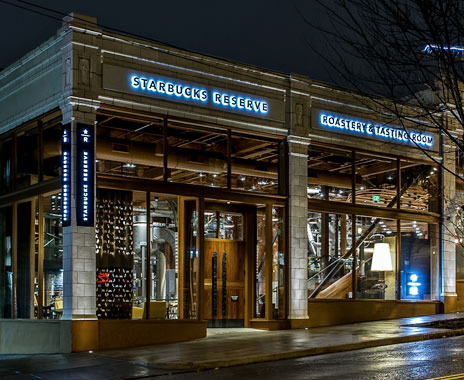Coffee isn’t just a convenient caffeine jolt for Americans anymore. A recent Harris Interactive survey found that consumers are willing to travel for a good cup of Joe; 60 percent of respondents said the primary coffee shop they visit is not necessarily the closest one. Sixty-six percent of Millennials, Americans ages 18–35, indicated they would travel longer for their favorite coffee.
That’s a big reason why Starbucks recently invested in its new Reserve Roastery and Tasting Room concept, a premier coffee destination that the company hopes will help it connect with a younger demographic increasingly looking for premium beverage options.
The first Roastery opened on December 5 in Seattle’s Capitol Hill neighborhood, nine blocks away from Starbucks’ first location in Pike Place Market.
“The 15,000-square-foot space dedicated to coffee will engage coffee-lovers like never before; they’ll see, smell, and taste first-hand the journey of coffee from roasting to brewing to the final hand-crafted beverage,” a spokeswoman for Starbucks says via e-mail.
The Roastery is home to Starbucks’ Reserve line of premium coffees from around the world. The consolidation of small-batch roasting, the spokeswoman says, allows Starbucks to expand the line to 1,500 global locations. Starbucks also has plans to open at least 100 Reserve-only stores in the U.S., starting this year in cities like Chicago, Los Angeles, New York, San Francisco, and Washington, D.C.
Starbucks’ Roastery and Tasting Room also offers a sensory-rich experience. Its copper silo is visible throughout the cafe, and lets guests hear the process of roasting coffee. A Solari board—reminiscent of a train station’s schedule board—highlights which coffee is being roasted and the source of the beans. Twenty-five Reserve blends are available throughout the year.
Industry experts believe Starbucks is keeping true to its original coffee mission with the Roastery, but also expanding its commitment to better serve the Millennial demographic. The new concept, they say, reaches out to the niche of coffee connoisseurs who would otherwise stick with independent shops.
“[With Starbucks’] new small-batch on-premise roasting concept, they’re going to be more visible and have more transparency with the end user,” says Tracy Allen, president and founder of Brewed Behavior, a coffee consultancy. “It’s more focused on becoming a part of the specialty/independent coffeehouse movement, not necessarily to bring more competition in the multiunit sector.”
David Henkes, vice president of market research firm Technomic, says several of Starbucks’ recent moves—the addition of alcohol sales in its Evenings concept, the roll out of more food options, and now the opening of the Roastery and Tasting Room—add layers to the brand in response to increasing competition and evolving consumer preferences, especially among Millennials. Starbucks has a good understanding of the Millennial demographic because those customers are in search of “an upscale fast-casual restaurant,” Henkes says. “With Millennials fleeing McDonald’s, everybody wants to market to this demographic.”
While spending power for Millennials is not at its peak, he adds, it will likely increase over time, and Starbucks is attempting to capture loyalty at an early stage. Today, the Millennial demographic is fractured into a few different sub-groups with varied levels of income. Data from Nielsen via MarketingCharts shows there are 77 million Millennials, comprising 24 percent of the U.S. population. Income for the 18–27 sub-group is $25,000 on average, while the 27–36 sub-group has an annual income average of $48,000.
The Starbucks Evenings concept, which debuted in 2010 and offers more upscale food options and alcoholic beverages, could be a good model for what Starbucks can accomplish with its Roastery and Tasting Room. Located in several major U.S. markets, Starbucks Evenings has proved a hit with the young and urban consumer set.
“The Starbucks Evenings program offers our customers a place to unwind in the evening and grab a coffee or glass of wine and a delicious bite to eat, without going to a bar or making a restaurant reservation,” the company’s spokeswoman says. “Starbucks Evenings locations have offered the same familiar and inviting coffeehouse atmosphere with more options in the evening, such as our shareable savory small plates and desserts that pair well with our coffee, tea, and thoughtfully selected wines.”
She adds that Starbucks Evenings is expected to roll out nationwide through fiscal year 2019 in as many as one in four Starbucks locations.
Henkes believes Starbucks’ upgrades are done to increase its competitiveness among different demographics. Adding alcohol to the menu will enhance store ambience, he says, and cater to consumers looking for a higher-end, fast-casual establishment.
However, since “coffee has been their lead-off,” Henkes says, the Roastery and Tasting Room concept is a “way for [Starbucks] to continue to cement themselves as a coffee expert, … a way to grow their brand and strengthen the relationship with their customer.”





